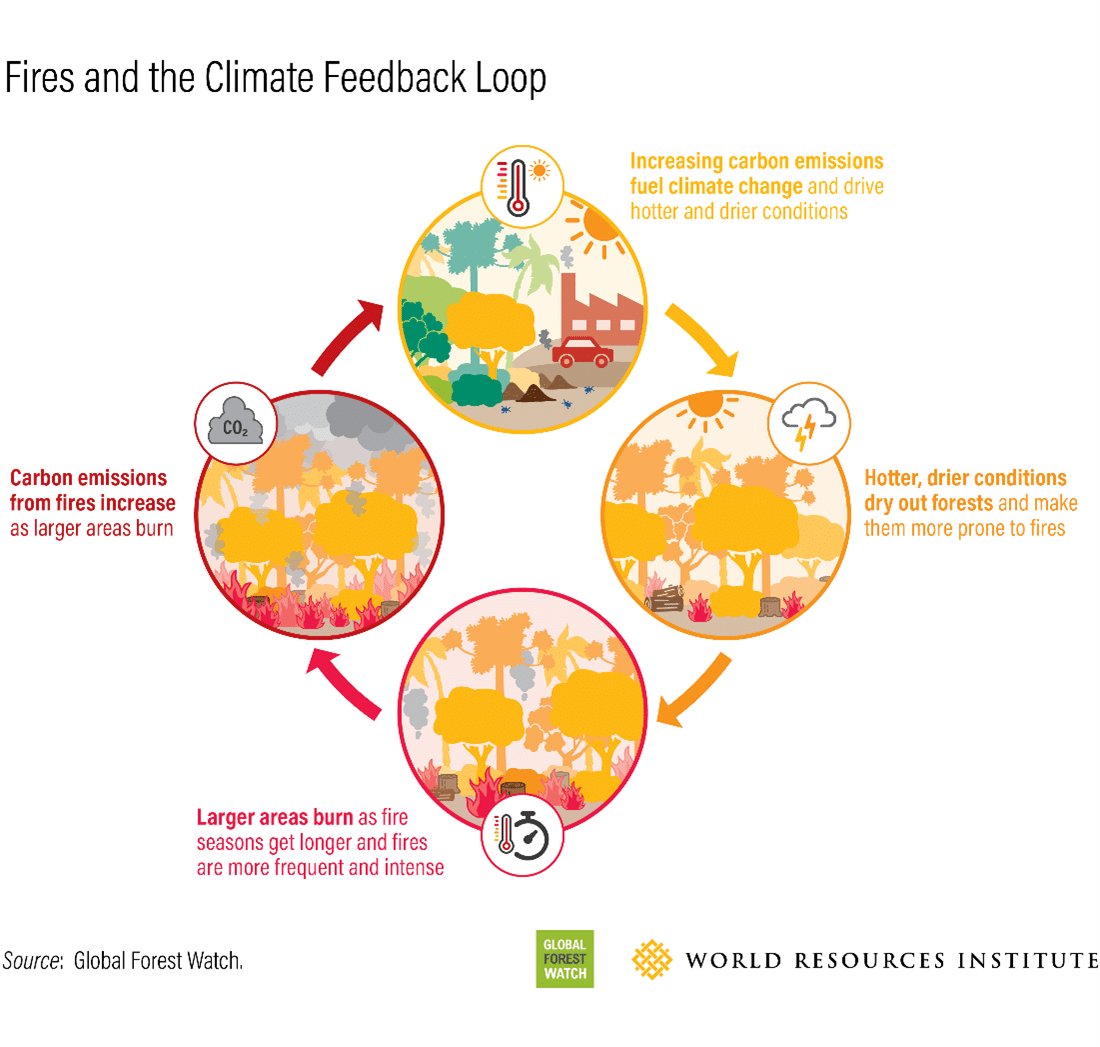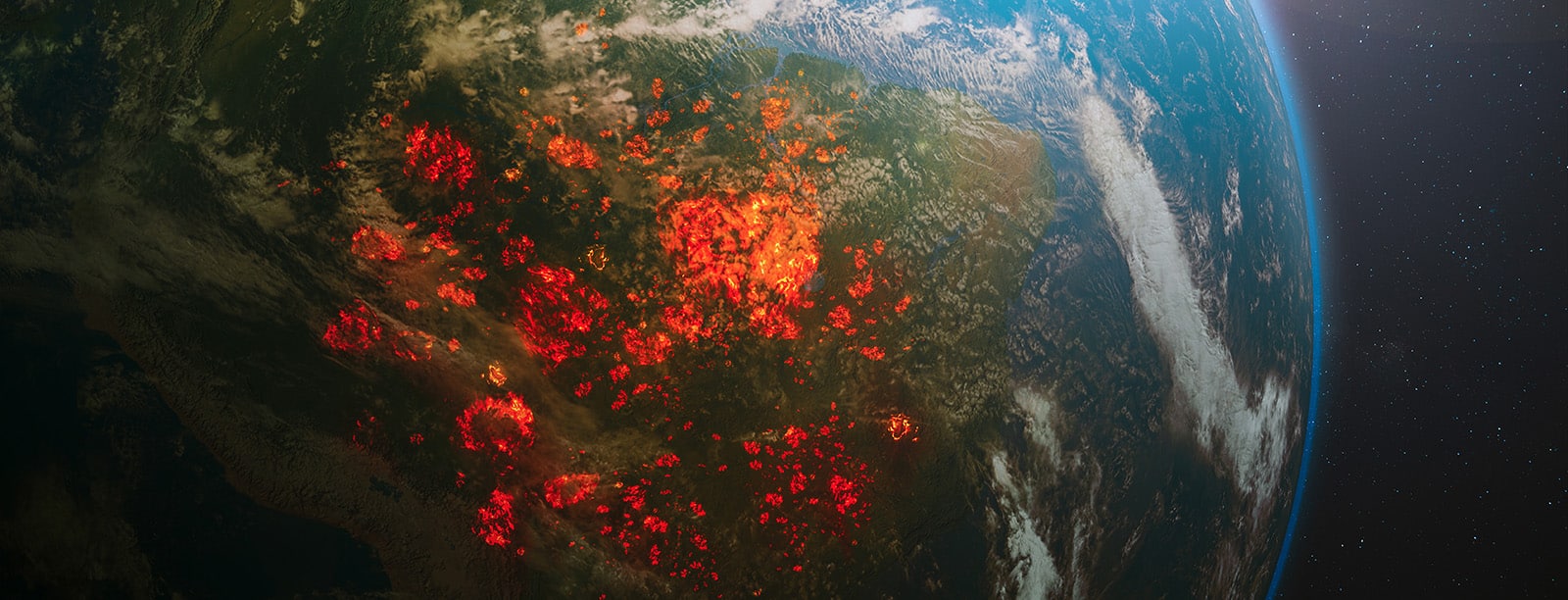The impact of climate change-induced wildfires is a reality society needs to acknowledge. While human activities are responsible for starting 90% of wildfires, climate change has heightened their intensity and scale. As weather patterns change, rising temperatures and drying forests have made wildfires a disastrous outcome of climate change. The destruction caused by the 2020 wildfires that ravaged over four million acres in California alone, spreading to Oregon, Washington, and other western states, is still fresh in the memory of many residents, including myself.
The cause of most of these fires was dry lightning, which occurs when the heat evaporates all moisture before it reaches the ground; another result of our warming climate. These fires have far-reaching impacts, affecting not only the animals living in the forests but also the quality of the air we breathe and our health and safety. This article explores the devastating impact of these wildfires, taking a closer look at the “burn factor.”
The impact of wildfires on our water supply is multifaceted and far-reaching. The devastating effects of these infernos extend beyond the loss of land and property to pose significant risks to our water systems. As fires rage and temperatures soar, water pollution becomes an imminent threat to our delicate aquatic ecosystems. The ash and debris from destroying vegetation and trees can contaminate our freshwater sources, causing long-term damage to human and wildlife populations. The toxic chemicals and heavy metals that infiltrate our water supply pose a significant risk to our health. They can accumulate in the bodies of aquatic organisms, disrupting their physiological functions.
Additionally, the excess nutrients brought into the water by ash can lead to an overgrowth of algae and eventual depletion of oxygen, harming marine life. Furthermore, sediment runoff from burnt areas can destroy crucial breeding grounds and spawning habitats, affecting the balance of our ecosystems.
Moreover, the water scarcity crisis that results from wildfires exacerbates the situation. The loss of vegetation and trees that absorb and retain water poses significant risks to water infiltration and groundwater recharge. As a result, water availability decreases for human consumption, irrigation, and other vital activities. This dwindling water supply can lead to a surge in droughts, further threatening our agriculture, local communities, and global food supply.
The numbers paint a grim picture as well. Of the planet’s 71% surface water, only 3.5% is freshwater, with most of it locked in glaciers. This 3.5% is the primary water source for consumption and irrigation, and the ongoing wildfire crisis is causing its steady depletion.
Furthermore, the destruction of trees due to wildfires creates additional water-related issues. Trees are essential in preventing erosion and stabilizing soil while regulating water flow. Without them, heavy rainfall can cause flash floods, washing away topsoil and causing sedimentation in rivers and streams. This sedimentation further harms aquatic habitats and increases the costs of filtration and purification.
Wildfire activity is more than just the destruction of forests and the displacement of wildlife; it is a complex environmental issue that severely affects our air quality and poses significant health risks for humans and animals. As fires rage and burn, they release harmful gases and particles into the atmosphere, contributing to the deterioration of our air. The ash on my car and the overall red sky in the photos are poignant examples of the devastating impact of wildfires on air quality, as evidenced during the lightning complex fires in California in 2020.
One of the main contributors to air pollution from wildfires is the emission of greenhouse gases, including carbon dioxide and methane. These gases trap heat in the atmosphere, exacerbating climate change and leading to more intense and frequent wildfires. As this cycle continues, more emissions are released, perpetuating the harmful effects on our air quality.
Besides greenhouse gases, wildfires release toxic chemicals and particulate matter, including smoke, ash, and soot. The wind can carry these particles over long distances, causing harm to those who inhale them. Smoke comprises a complex mixture of chemicals and pollutants, including carbon monoxide, volatile organic compounds, and small particles known as PM2.5. These tiny particles can penetrate our lungs and enter our bloodstream, leading to respiratory issues, exacerbating asthma, and increasing the risk of heart attacks and other cardiovascular diseases.
The impact of wildfires on agriculture can also be significant, destroying trees and pollutants settling on crops and contaminating soil, affecting food quality, safety, and the environment.
Wildfires can have far-reaching and long-lasting consequences on the Earth’s surface, particularly decimating tree populations. This destruction of trees has significant implications for our environment and society, such as the loss of habitat for diverse wildlife and the increase of soil erosion.
The absence of trees on the Earth’s surface can increase soil erosion, particularly during heavy rainfall. Tree roots help anchor the soil, preventing it from being washed away by rain and wind. When wildfires destroy these trees, the ground becomes more vulnerable to erosion, resulting in the loss of topsoil, which is essential for agriculture and plant growth.
The destruction of trees due to wildfires can also release greenhouse gases into the atmosphere, particularly carbon dioxide, a significant greenhouse gas. Trees act as natural carbon sinks, absorbing and storing carbon dioxide. However, when trees get destroyed, the stored carbon is released into the atmosphere, contributing to climate change and further exacerbating the conditions that fuel wildfires.
The decimation of tree populations caused by wildfires has multifaceted effects on the Earth’s surface, from habitat loss and increased soil erosion to the economic implications of resource shortages. The consequences of these effects are significant and can have long-lasting impacts on our environment and society.
This leads us to wildfires, which wreak havoc on wildlife and their habitats, causing disruptions in delicate ecosystems and endangering biodiversity. These catastrophic events can result in the loss of numerous species and upset crucial food chains, leading to imbalances in natural environments.
The impact of wildfires on wildlife is immediately apparent through the destruction of habitats. These infernos engulf vast tracts of land, leaving scorched and lifeless terrain behind. The loss of vegetation and trees deprives countless animals of essential resources such as shelter, nesting sites, and food sources. Animals that rely on specific habitats, such as tree-nesting birds or mammals that depend on undergrowth cover, are especially vulnerable to losing these vital resources.
Wildfires can also have a direct and catastrophic effect on animal populations. The intense heat and flames can cause immediate fatalities, trapping and suffocating animals or causing severe burns. Those who survive may struggle to find sufficient food and water. The disruption of food sources can also trigger a domino effect throughout the food chain, influencing predator-prey dynamics and causing imbalances in the ecosystem.
The far-reaching consequences of wildfires on wildlife and their habitats pose significant threats to the health and resilience of ecosystems. The loss of biodiversity impacts the natural world and has crucial implications for human survival. The stability of critical ecosystem services such as pollination, water filtration, and pest control rely on the diversity and vitality of ecosystems.
Wildfires harm the natural environment, pose risks to human health, and significantly affect industries that rely on natural resources. In particular, the paper, lumber, and pencil industry experiences severe consequences due to the destruction caused by wildfires. As trees, the primary source of raw materials for these industries, are decimated by flames, a shortage in the timber supply becomes inevitable, significantly affecting the production of paper, lumber, and pencils. The resulting scarcity of these essential products can have a broader impact on our daily lives, from the availability of packaging materials to the production of books and newspapers.
Algae bloom Smartsville CA-Photo credit EWY Media
The paper shortage caused by wildfires can affect various aspects of our lives. As trees burn, the supply of tree fibers, a crucial component of paper production, decreases, leading to higher costs for paper products and reduced availability. Lumber, another vital resource, is used in construction and rebuilding efforts in fire-affected areas. As wildfires destroy forests, the timber supply is negatively affected, leading to delays in rebuilding homes, infrastructure delays, and increased construction project costs.
Producing pencils is also profoundly impacted by wildfires, particularly species like cedar, which are essential for pencil manufacturing. The loss of tree populations due to wildfires can disrupt the supply chain of pencil production, leading to a shortage of pencils. This scarcity affects students, artists, and industries reliant on pencils for their day-to-day operations. Every year, 82,000 trees turn into 14 billion traditional wooden pencils, making pencils’ increased costs and limited availability a significant concern for educational and creative endeavors.
The increasing threat of wildfires, intensified by climate change, has become a significant global concern that devastates our environment, wildlife, and society. The impact of these wildfires is far-reaching, affecting not only immediate destruction but also the quality of our water and air, the population of trees, and industries that depend on them. This “burn factor” highlights the interconnectedness of our ecosystem and the urgency to address underlying causes and take proactive measures to mitigate the devastating impacts of wildfires.
As we explore the “burn factor,” it is clear that wildfires significantly threaten our water supply, air quality, wildlife, and habitats. Moreover, the decimation of tree populations affects the availability of vital resources such as paper, lumber, and pencils, which, in turn, affects our daily lives and industries. The far-reaching implications of wildfires for the stability of ecosystems and the overall health of our planet demand attention and action from the global community.
The risks associated with wildfires go beyond environmental damage, as inhalation of smoke and the instability of land after fires can have severe consequences for human well-being, particularly for vulnerable populations. Therefore, effective prevention, mitigation, and emergency response strategies are essential.
As a global community, we cannot ignore the underlying causes of the “burn factor” of wildfires, such as climate change. Implementing strategies like sustainable forest management, actively reducing greenhouse gas emissions, and researching more renewable alternatives like bamboo can help protect our environment, safeguard human health and safety, and ensure the availability of vital resources for future generations. Proactive measures can restore and cover the delicate balance of nature, and it is up to us to work together to impact the world positively.



























